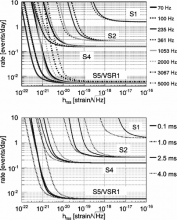
Abstract
We present results from an all-sky search for unmodeled gravitational-wave bursts in the data collected by the LIGO, GEO 600 and Virgo detectors between November 2006 and October 2007. The search is performed by three different analysis algorithms over the frequency band 50–6000 Hz. Data are analyzed for times with at least two of the four LIGO-Virgo detectors in coincident operation, with a total live time of 266 days. No events produced by the search algorithms survive the selection cuts. We set a frequentist upper limit on the rate of gravitational-wave bursts impinging on our network of detectors. When combined with the previous LIGO search of the data collected between November 2005 and November 2006, the upper limit on the rate of detectable gravitational-wave bursts in the 64–2048 Hz band is 2.0 events per year at 90% confidence. We also present event rate versus strength exclusion plots for several types of plausible burst waveforms. The sensitivity of the combined search is expressed in terms of the root-sum-squared strain amplitude for a variety of simulated waveforms and lies in the range 6×10-22 Hz-1/2 to 2×10-20 Hz-1/2. This is the first untriggered burst search to use data from the LIGO and Virgo detectors together, and the most sensitive untriggered burst search performed so far.